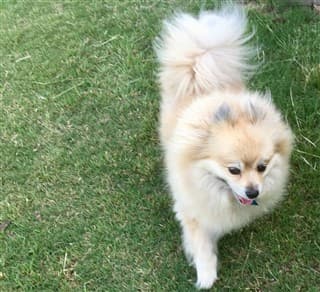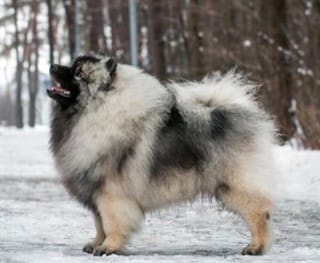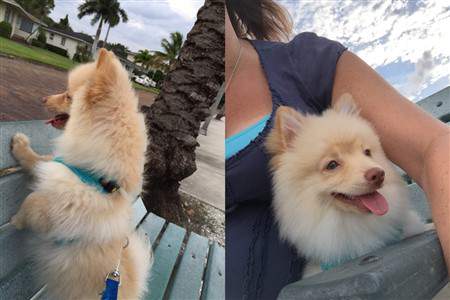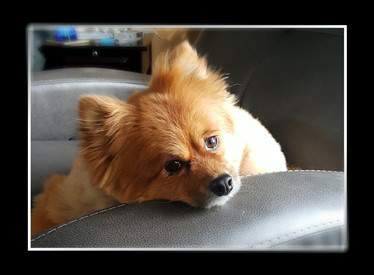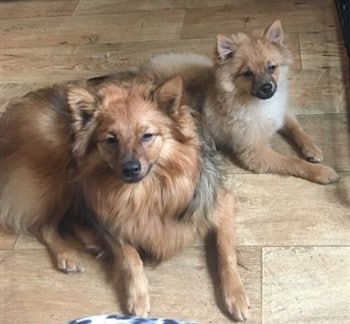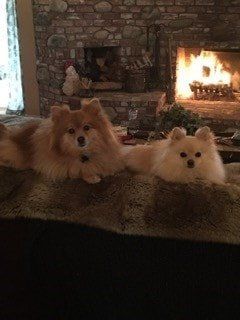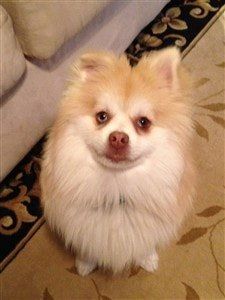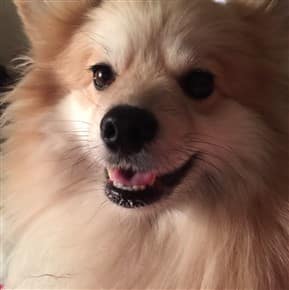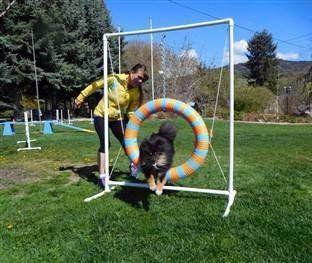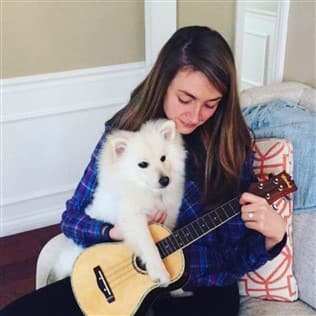Throwback Pomeranian Dogs
Overview
Though there is only one Pomeranian breed and no official varieties regarding size or any other physical attributes, there is such a thing as a throwback Pomeranian. This article will cover exactly what this is and what it takes for a Pomeranian to be classified as a throwback. We'll also take a look at photos of some gorgeous throwback guys and gals.
A true throwback Pomeranian is a purebred Pom that is genetically more similar to his ancestors (large Spitz-type sled dogs) in size, and sometimes behavior, than the Pomeranian breed that we know today.
Typically, a dog's traits are passed down primarily from their parents (sire and dam) and it's not uncommon for some genes to be passed down from up to 5 generations back. But with throwbacks, genes are 'thrown' from much further back, from those long-ago ancestors.
The AKC breed standard size of the Pomeranian is a tiny 3 to 7 pounds (which applies to just about all Poms in conformation show rings) and the actual size of pet Pomeranians is anywhere in the range of 3 to 12+ pounds. Yet a full throwback Pomeranian will be a very large Pom that's at least 14 pounds and sometimes as big as 20 or even 30-something pounds.
In some cases, behavior is affected as well. Today's Pomeranian is a gentle indoor lap dog but they do possess some behaviors carried down over the generations such as being alert and adaptable to new situations. However, throwback Pomeranians may display certain behaviors such as a desire to spend lots of time outside, having the urge to chase after small wild animals (squirrels, chipmunks, etc.), and sometimes being hard to housebreak.
This is Scamp, a full throwback Pomeranian, seen at 6 years old
and 15 lbs. (6.8 kg) and with Olivia Lopez. Photo courtesy of Mariano Lopez
What Qualifies a Pom to be a Throwback?
There are a few elements that must be present for a Pomeranian to qualify as a true full throwback:
#1 The Pom must be at least 14 pounds (6.35 kg). There is no maximum size.
#2 The Pom must be a purebred with no other breed in the bloodline. Sometimes, if a Pom is bred with another Spitz breed such as the Finnish Spitz or Japanese Spitz, they can look just like a really large Pomeranian but but actually be a mixed breed, so this must be ruled out. It's important to note that this does not just apply to a Pom's parents; no other breed should appear in the gene pool for at least 5 generations back (great-great-great-great grandparents).
#3 The large size must not be due to being overweight. Though carrying excess weight is not overly common with toy breeds like the Pomeranian, it's entirely possible for a Pom with solid bone-structure to become overweight.
Partial throwbacks:
Maybe your Pom is larger than other Poms, but not quite a big as a throwback. You're pretty sure that they're not overweight. So, what could it be? Adults that are not overweight and are over 7 pounds (3.175 kg) which is the maximum AKC breed standard, but under 10 pounds (4.53 kg) simply have sturdy bone structure. Adult Pomeranians that are not overweight and are between 10 pounds (4.53 kg) and 14 pounds (6.35 kg) may have partial throwback genes.
How to Know if a Suspected Throwback is Indeed a Purebred Pomeranian
To tackle this question, let’s look at the AKC, since in the US it is the American Kennel Club that is the most trusted regarding the validity of purebred dogs. For all breeds, a purebred is one that has documented pedigree in a stud book. The AKC requires a 3 generation pedigree. This means there will be proof that the Pomeranian’s parents, grandparents, and great-grandparents are all purebred (and since they needed to be registered, they each have their own 3 generation pedigree).
Therefore, when a Pomeranian is AKC registered, you can feel very confident that he or she is indeed a purebred even if the dog is a large throwback size. In spite of that, it cannot be 100% guaranteed; hypothetically, a pup can be sired by a dog other than the one listed in the papers.
Now, with some other kennel clubs, such as the Continental Kennel Club, there may be more doubt when it comes to a throwback Pomeranian and the question of being purebred. Their rules for proving lineage are less strict. The signatures of two people who state that a dog is purebred along with 5 photos of the dog will result in CKC registration, as long as the images depict a dog that is ‘proper breed type.’
For the Pomeranian, ‘proper breed type’ would be Spitz-like, which includes many dogs that look similar to Pomeranians, at least in some aspects, such as the Alaskan Klee Kai, American Eskimo Dog, Danish Spitz, Eurasier, Keeshond, etc.
So the question remains: Is an over-sized Pom a throwback Pomeranian or a Pom with another breed mixed in? Unless a breeder has pedigrees going back many generations, without DNA testing, the answer will not be known.
Meet Louie Vuitton Feather, a gorgeous throwback Pomeranian.
Louie's owner, Terry, contacted us when her Pom was 7 lbs. 4 oz . at the 16 week old mark.
We estimated the adult weight to be 11.2 pounds, minimum, which
would have made him a partial-throwback.
Louie Vuitton was 15 pounds at 9 months, then 17 pounds at 11 months.
Update! 18.2 lbs. at almost 1 and 1/2 years old.
Throwback FAQ
Do throwbacks have any known health issues?
Though extensive studies have not been conducted as of yet, there are no known health issues seen with throwback Pomeranians above and beyond health issues common to Pomeranians
in general. In fact, being a sturdier, larger size than standard Pomeranians can actually be an asset. With very small dogs, there is a greater risk of size-related injuries such as pulled ligaments or damaged knees from leaping off furniture and injury from being dropped or accidentally stepped on.
Can a throwback Pomeranian come from the same litter as standard Poms?
Yes, in fact this happens more often than not. Since this genetic jump is very rare, many throwbacks will have siblings of either standard or just slightly above average size.
Where can I find a throwback Pomeranian?
It's very common for someone who had a throwback in the past to want another large Pomeranian. They love the combination of such an endearing personality and a bigger, sturdier size that lets their dog do many things that tiny dogs cannot.
However, this is a lot easier said then done. Just about all Pomeranian breeders
try to adhere to the Pomeranian breed standard, as set by the Pomeranian Club of America and as adopted by the AKC and used to judge conformation events.
In fact, breeders take a pledge to breed with the 'betterment of the breed' in mind which means pairings are done with the goal of staying as close as possible to the standard in regard to all physical aspects including size. Reputable breeders will pair certain dogs so that one's weakness is improved by the strength in the other. So, the goal is not to produce Pomeranians significantly larger than the standard's maximum (7 lbs.).
In addition, this sort of genetic jump in the gene pool is random. It cannot be planned. Most breeders are very surprised when a throwback occurs. And even if the same sire and dam of a throwback were to be paired at a future time, there would be no guarantee at all that a throwback would occur again.
Our best advice for anyone looking for a throwback Pomeranian puppy is to contact as many reputable breeders as possible that strive toward the higher end of the standard (6 to 7 lb. range) and ask to be placed on a waiting list for a larger-than-expected pup. Though Pomeranian growth charts
are just mere estimates and the end result can be a surprise, more often than not a large puppy will mature into a large adult; they may not be a full throwback but could be a partial one.
Another option is to consider obtaining a different breed that's in the Spitz family. Though, in the US just about all other Spitz dogs are a bit hard to come by. Some of the breeds that resemble the Pom but are much larger in size include the American Eskimo Dog, Danish Spitz, German Spitz, Finnish Lapphund, Japanese Spitz, Keeshond, and the Volpino Italiano.
Photo Slideshow of More Throwback Pomeranians
You may also like:
How to Keep a Pomeranian Safe
- Don't be sorry in hindsight that you didn't do these things. Our top tips for keeping your Pomeranian safe from both indoor and outdoor dangers.
Best Toys for Pomeranians
- Whether you have a teething puppy, an adult that loves to chew, or a guy or gal that you want to help keep busy, these are our top picks for toys that can help in a number of situations.
Best Shampoos for Pomeranians
- What you use on the coat can have a huge effect on both skin and fur. This article covers both regular shampoo and coat products and specialty shampoo to treat allergies and other issues.


